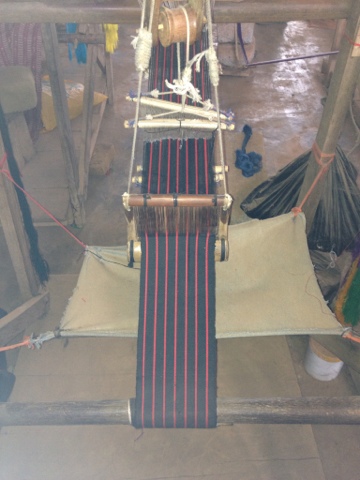So it has been some time since I have posted a substantial post but with preparations to go to Ghana time has been limited...alas, I am in Ghana and so the adventures have begun! In my first post from this beautiful country, I have had the opportunity to explore the creation of Kente. I have been using Kente in my designs since the beginning of mefie.co.uk and there has definitely been a great response to the print. The intention while I are here is to expand its use re-purposing it in new and exciting ways. Initially, I had gone to the hub of the Ghanaian retail sector and carefully selected fabrics from the markets but on this trip I wanted to explore where this great traditional weave originates. It would be a shame not to really explore kente and understand not only where it comes from but what it means.
Kente cloth originated in the Ashanti kingdom and was traditionally worn by the kings. Even today there are special weaves which are only worn by royalty. Over time its use has become more widespread although it is still traditionally worn and used for special occasions. The cloth is woven in strips and each of the woven patterns has a meaning. As one of the weavers explained yesterday ' they don't just weave for beauty but to communicate a meaning.' Hence, each of the cloths is special and unique in its own right.
So yesterday, I had the opportunity to travel to the main area in the Ashanti region where Kente cloth is produced, Bonwire. The town is only about 40 minutes outside of Kumasi and upon my approach I was surprised by how small and remote the township is. As many of you may know, Kente is one of, if not THE most famous woven African cloth so I had imagined a large building to house all of the kente weavers. I can remember watching The Cosby Show in the '80s and seeing Cliff and Claire in various Kente throws so my imagination ran wild. Instead as we left Kumasi, we were met with two inconspicuous signs which directed us to a small building behind some houses where kente is made.
After greeting the weavers outside of the building, I entered into a room where I was met with a variety of beautiful weaves as well as various weaving benches. The craft is dominated by men who create the beautiful patterns. One weaver explained that although newer designs have been created, many have also been passed down through generations over time. The price for the kente varies depending on the different type of cloth created (ie. there are single, double and triple weaves), and the intricacy of the designs. I was really surprised to find out that a weave can take anywhere from 6 weeks to 6 months to complete depending on the difficulty.
I also had the opportunity to try to weave and I have to say that if I were to weave for a day I would not have to hit the gym for a while as the process of pulling on the strings with your feet in order to change the direction of the weave while passing the spools of thread through the apparatus is a workout. After about 5 minutes of weaving my thighs began to feel the burn...and as an avid spinner and Insanity convert I was surprised by the physical labour involved.
Overall, my trip to Bonwire was an eye-opening experience. It was great to see how this beautiful cloth has come into existence but sad to know that despite the great popularity and fame of the cloth this area still remains quite underdeveloped. I will be going back to Bonwire over the next few weeks and hope to have the opportunity to develop a longer terms relationship with the weavers in the area.
I hope you enjoy the journey
xx mefieuk













wow! You tried weaving! Good job Sammy xx
ReplyDeleteIvy
Thanks Ivy....it was a good experience!
ReplyDelete